Printable primary worksheets
All of our resources come complete with answer sheets to save time for busy teachers and parents. Input your child’s scores and keep track of your child's progress.
worksheet plans from £3.20/monthAll of our resources come complete with answer sheets to save time for busy teachers and parents. Input your child’s scores and keep track of your child's progress.
worksheet plans from £3.20/month Free
Free
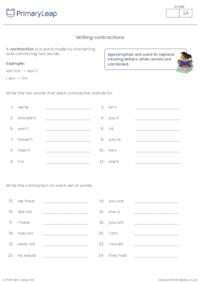
Writing contractions worksheetThis worksheet is designed to reinforce the understanding of contractions by matching them with their corresponding two-word forms. Students will practise recognising and forming contractions for common word pairs.
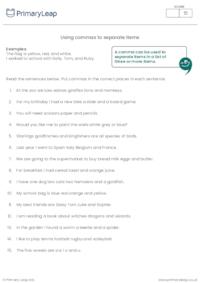
Using commas to separate itemsThis worksheet is designed to reinforce the use of commas in lists. Students will practise inserting commas in sentences to separate items in a series, improving their understanding of punctuation rules.
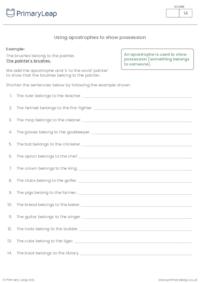
Using apostrophes to show possessionThis handy worksheet will help to reinforce the understanding of possessive apostrophes by shortening sentences. Students will practise transforming sentences to possessive form by adding apostrophes and 's' to indicate ownership.
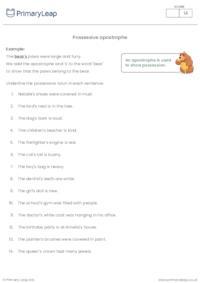
Possessive apostrophe worksheetThis worksheet will help to reinforce the concept of possessive nouns and their usage of apostrophes. Students will practise identifying possessive nouns in sentences by underlining them, promoting an understanding of ownership in language.
 Free
Free
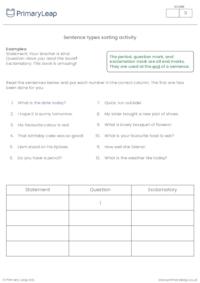
Periods, question marks, and exclamation marksUse this worksheet to help students practise identifying and categorising different types of sentences—statements, questions, and exclamatory sentences. By reading sentences and placing them in the correct column, students reinforce their understanding of sentence types.
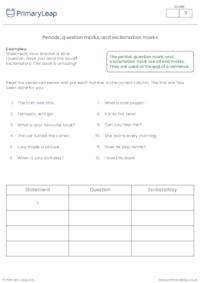
Periods, question marks, and exclamation marksUse this worksheet to help students practise identifying and categorising different types of sentences—statements, questions, and exclamatory sentences. By reading sentences and placing them in the correct column, students reinforce their understanding of sentence types.
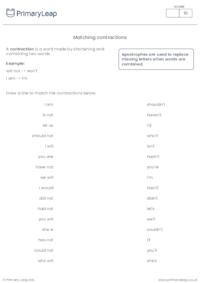
Matching contractionsWith this worksheet, students are asked to draw lines to connect contractions with their corresponding expanded forms, practising the recognition of common contractions.
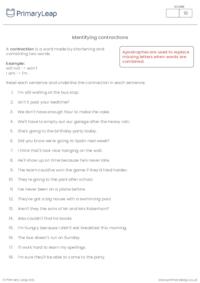
Identifying contractionsUse this resource to help students practise identifying contractions within sentences. By providing sentences containing contractions, students will read each sentence and underline the contraction present, reinforcing their understanding of how contractions are formed.
 Free
Free
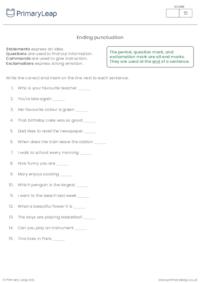
Ending punctuationThis worksheet for ESL students provides a practical exercise to apply their knowledge of sentence types and corresponding end marks.
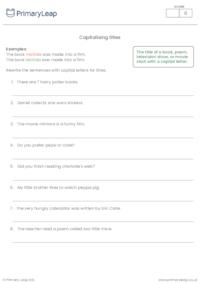
Capitalising titlesThis worksheet will help to reinforce the proper capitalisation of titles within sentences. By providing sentences with lowercase titles, students will practise rewriting them with correct capitalisation, enhancing their understanding of language conventions.
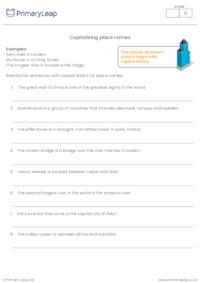
Capitalising place namesThis handy worksheet aims to reinforce the proper capitalisation of place names within sentences. By providing sentences with lowercase place names, students will practise rewriting them with correct capitalisation, enhancing their understanding of language conventions.
 Free
Free
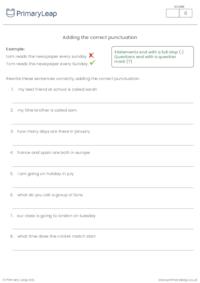
Adding the correct punctuationUse this great resource to help your students practise using correct punctuation in sentences. By providing sentences without proper punctuation, students will rewrite them with accurate punctuation, reinforcing their understanding of sentence structure.
 Free
Free
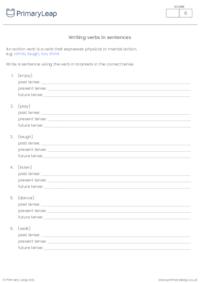
Writing verbs in sentencesThis worksheet is designed to guide students in practising the use of action verbs in different tenses—past, present, and future. By providing a variety of verbs, students will construct sentences that showcase their understanding of verb tense application.
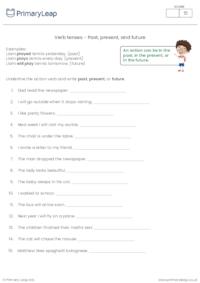
Verb tenses - Past, present, and futureUse this worksheet in the classroom or at home to help students practise identifying verb tenses, specifically focusing on past, present, and future tenses. By underlining the action verb in each sentence and indicating the corresponding time (past, present, or future), students reinforce their understanding of verb tense usage.
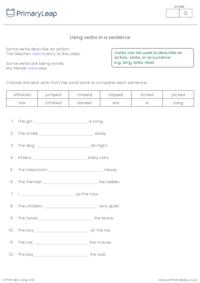
Using verbs in a sentenceThis worksheet aims to engage students in distinguishing between action verbs and being verbs. By selecting the appropriate verb from a word bank to complete sentences, students will reinforce their understanding of verbs that denote actions and those that express a state of being.
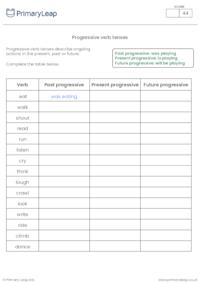
Progressive verb tenses activityThis worksheet will help to reinforce students' understanding of progressive verb tenses, including present progressive, past progressive, and future progressive. By completing a table with an example, students will enhance their proficiency in recognising and forming verbs in various progressive tenses. This resource is ideal for ESL students to practise verb conjugation.
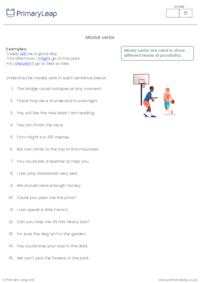
Identifying modal verbs activityUse this helpful worksheet to reinforce students' understanding of modal verbs by engaging them in an activity that involves underlining modal verbs in given sentences. Modal verbs express possibility, necessity, ability, or permission, and this activity is designed to enhance students' recognition and usage of these verbs.
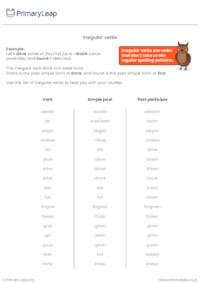
Irregular verbs listUse this handy information sheet to help students strengthen their understanding of irregular verbs and their past simple forms. By providing examples and a list of irregular verbs, students will practise converting verbs to their past simple forms, enhancing their proficiency in recognising and using irregular verbs in different tenses.
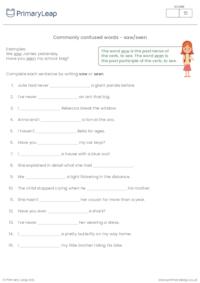
Commonly confused words - saw/seenThis worksheet is designed to reinforce students' understanding of the verbs "saw" and "seen" in different contexts. Through completing sentences, students will practise choosing the correct form of the verb to accurately convey past events and present perfect actions.
 Free
Free
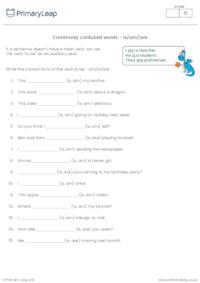
Commonly confused words - is/am/areThis handy worksheet is designed to reinforce students' understanding of the verb "to be" as an auxiliary verb when a sentence lacks a main verb. Through a set of exercises, students will practise selecting the appropriate form of "to be" (am, is, are) to complete sentences correctly, enhancing their awareness of auxiliary verb usage.
 Free
Free
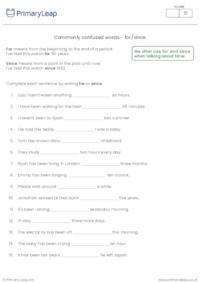
Commonly confused words - for/sinceThis worksheet aims to provide students with a clear understanding of the distinctions between the usage of "for" and "since" when expressing duration or time. Through contextual exercises, students will practise choosing the appropriate word to complete sentences, enhancing their grasp of these temporal prepositions.
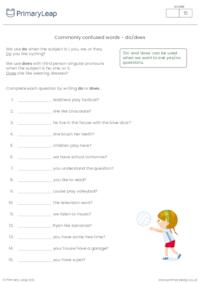
Commonly confused words - do/doesThe objective of this worksheet is to reinforce the correct usage of "do" and "does" in English sentences, particularly concerning subject-verb agreement. Students will practise selecting the appropriate form based on the subject, which can be singular or plural. Students complete each sentence by choosing the correct form of the verb ("do" or "does") to fill in the blank.
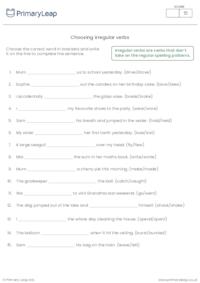
Irregular verbs activityThis worksheet is designed to reinforce students' understanding of irregular verbs by providing sentences with gaps. Students are tasked with selecting the correct irregular verb in the past tense to complete each sentence. This exercise aims to enhance their ability to recognize and use irregular verbs in context.
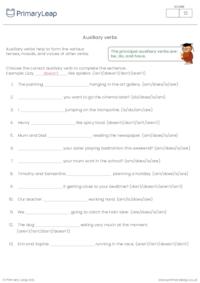
Auxiliary Verbs ActivityThis handy worksheet is designed to help ESL students grasp the concept of auxiliary verbs and their role in forming different tenses, moods, and voices of other verbs. By providing sentences with gaps, students are challenged to select the appropriate auxiliary verb, enhancing their understanding of verb conjugation and sentence structure.
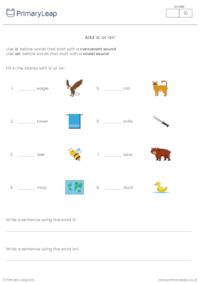
Indefinite Articles: a or anThis worksheet for ESL students focuses on refining article usage in English. The purpose of this educational resource is to assist students in mastering the subtle yet crucial distinction between 'a' and 'an' in various contexts. Students will practise when to use 'a' and when to use 'an' before words that begin with consonant and vowel sounds. An answer is provided, allowing both students and educators to assess progress and correct any errors.
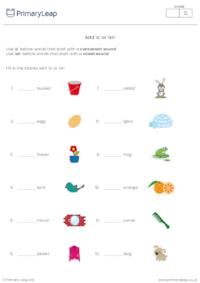
What are indefinite articles?Indefinite articles, specifically "a" and "an," are used to refer to non-specific items or things. The choice between "a" and "an" depends on the sound that follows the article:"A": Use "a" before words that begin with a consonant sound. For example:"I saw a car in the carpark.""An": Use "an" before words that begin with a vowel sound. For example:"I saw an owl in the tree."By incorporating this worksheet into your ESL curriculum, you provide students with a valuable tool to sharpen their English language skills.
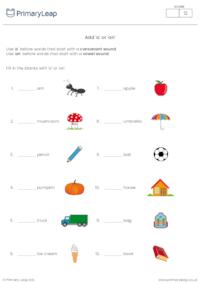
"A" and "an" are the indefinite articles in English. They are used before a noun to indicate that the noun refers to something non-specific or not known to the reader or listener. The choice between "a" and "an" depends on the sound that follows the article, not the actual first letter. For example:"I saw a cat in the backyard.""I saw an interesting movie yesterday."It's important to note that the choice between "a" and "an" is based on the sound that follows the article, not the actual first letter. For instance, "an hour" is correct because "hour" begins with a vowel sound, and "a university" is correct because "university" begins with a "ju" sound, which is a consonant sound.With this worksheet, students fill in the blanks with 'a' or 'an'.
 Free
Free
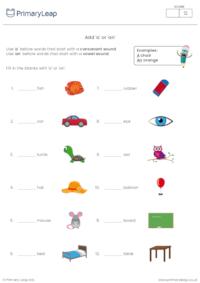
Indefinite Articles: a or anThis worksheet for ESL students focuses on refining article usage in English. The purpose of this educational resource is to assist students in mastering the subtle yet crucial distinction between 'a' and 'an' in various contexts. Students will practise when to use 'a' and when to use 'an' before words that begin with consonant and vowel sounds. An answer is provided, allowing both students and educators to assess progress and correct any errors.




Check out our ready-to-use worksheets that can be used in the classroom or at home. Simply download or print and watch your child’s confidence grow with our easy to follow printables.


One of the best things about printable worksheets is that they make learning fun and easy. Explore our educational resources based on and keep your children learning through these fun and engaging exercises.


Our printable worksheets are designed for progressive learning. Our engaging content enables a child to learn at their own speed and gain confidence quickly. When we help a child believe in themselves, we empower them for life.


Printable worksheets are a great way to enhance creativity and improve a child’s knowledge. Help your child learn more about with this great selection of worksheets designed to help children succeed.
An email has been sent to your account please activate your account to continue.

PrimaryLeap has introduced a new interactive learning platform and would like to offer you a completely Free Upgrade.
We understand that you may only want to use our services for worksheets and may not want to upgrade your account.
But if you are interested in trying out our new services then you're just a click away.
An email has been sent to your account please activate your account to continue.
You've answered
and have 2 Questions remaining
Import multiple students information through a CSV File. Browse or drag .CSV file below.